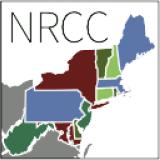Drought intensifies and expands as streamflow declines and crops are stressed.
For more details, see the Northeast Drought Early Warning System Dashboard.
Key Points
- Severe drought (D2) developed in northeastern Massachusetts and a small portion of southern New Hampshire.
- Moderate drought (D1) expanded in coverage across most of New England and emerged in western New York.
- Abnormally dry conditions (D0) expanded significantly to include most of New England and western and central New York.
- Abnormally dry conditions (D0) also expanded in southeastern New York state—including New York City.
Current U.S. Drought Monitor map for the Northeast Drought Early Warning System with data valid for July 12, 2022. The U.S. Drought Monitor is updated each Thursday to show the location and intensity of drought across the country.
According to the latest U.S. Drought Monitor:
- Severe drought (D2) conditions exists in 1.78% of the region.
- Moderate drought (D1) conditions exist in 34.57% of the region.
- Abnormally dry (D0) conditions exist in 28.60% of the region.
U.S. Drought Monitor Categories
Current U.S. Drought Monitor map for the Northeast Drought Early Warning System with data valid for July 12, 2022. The U.S. Drought Monitor is updated each Thursday to show the location and intensity of drought across the country.
According to the latest U.S. Drought Monitor:
- Severe drought (D2) conditions exists in 1.78% of the region.
- Moderate drought (D1) conditions exist in 34.57% of the region.
- Abnormally dry (D0) conditions exist in 28.60% of the region.
Current Conditions
U.S. Drought Monitor 1-Week Change Map

Animation: 2022 U.S. Drought Monitor Conditions in the Northeast

Accumulated Precipitation Departure from Normal

Accumulated Potential Evapotranspiration (PET) Departure from Normal

State-Reported Impacts
Connecticut
-
July 11, 2022: NBC Connecticut – Eastern Connecticut Farms in Drought
Maine
- July 14, 2022: Maine.gov Press Release – State Drought Task Force to Convene in August
- July 6, 2022: News Center Maine – Blueberry Fields
- June 13, 2022: News Center Maine – Dry Conditions in Western Maine
Massachusetts
- July 13, 2022: Boston Herald – Ninety Percent of State in Drought
- July 13, 2022: Boston.com – State Energy and Environmental Affairs Updates Drought Status
- July 13, 2022: WBUR – Drought is Worsening
- July 1, 2022: WCVB Boston – Low Stream Flows
- July 14, 2022: Update from Dave Celino, Chief Fire Warden, Massachusetts Department of Conservation
- Drought-induced fire activity increased this week with numerous wildland fires burning deeper into the upper soil layer and presenting control challenges for state and local fire resources. Light fuels are showing beginning signs of curing from drought stress.
- Old City Fire, Townsend, MA: Stared on Sunday July 10 in a remote area of Willard Brook State Forest. The fire is holding at 15 acres and burned up to 10 inches into the ground across much of the area. Currently, it is considered 95% contained and in patrol status due to drought conditions and interior deep burning.
- Water Availability and Soils: Many tributary streams are found to be dried up, or with little water available as a water supply resource. Grass and shrub fuels are starting to show signs of drought stress and curing in the central and eastern parts of the state, which will add to fuel availability.
New Hampshire
- July 14, 2022: WMUR – Water Restrictions and Water Conservation Requests
- July 7, 2022: WMUR – Moderate Drought in More Than Half the State
New York
- July 14, 2022: New York State Department of Environmental Conservation – Fire Danger Reminder
- July 8, 2022: RochesterFirst.com – Crop Concerns
- July 7, 2022: The Packer – Crop Optimism
Vermont
- July 8, 2022: Valley News – Upper Valley Summer Drought
- July 7, 2022: The Keene Sentinel – Abnormally Dry Conditions Spread
Streamflow at Saxtons River, Vermont


Outlooks
- According to the Climate Prediction Center's 8–14 day outlook (valid July 21–21), odds favor above-normal temperatures and near-normal precipitation across the Northeast.
- The week 3–4 outlook (valid July 23–August 5) predicts a greater likelihood of above-normal temperatures across the region. Odds favor above-normal precipitation for most of the region, except far-northern Maine and far-western New York, which have equal chances of above- or below-normal precipitation.
8–14 Day Temperature Outlook

8–14 Day Precipitation Outlook

Temperature Outlook Week 3–4

Precipitation Outlook Week 3–4

What We Are Watching
Monitoring potential drought introduction, expansion, or intensification on Northeast DEWS borders:
- Abnormally dry conditions (D0) in western New York expanded into northwestern and north-central Pennsylvania.
- Abnormally dry conditions (D0) have also developed in northern New Jersey, connecting to developing dryness in the New York City area and southwestern Connecticut.
Monitoring agriculture reporting systems:
- In New York state, corn and hay crops are stressed. Some farms are using irrigation systems but anticipate problems if rains don’t supply relief.
NIDIS and Northeast DEWS News
The Northeast DEWS has selected a date and location for its 2022 Partners Meeting. The meeting will be held on Tuesday, November 1 and Wednesday, November 2. The meeting will be held at the Queensbury Hotel and Conference Center in Glens Falls, New York. Agenda and travel information will be made available in the coming weeks.
Additional Resources
This week we feature several resources related to soil moisture monitoring, drought statistics, drought/heat/health awareness, and links to state level reservoir and dry well information and support:
- Soil Moisture Data and Maps on Drought.gov
- Cumulative U.S. Drought Monitor statistics in the Northeast
- Learn more about the Landscape Evaporative Response Index (LERI)
- LERI is the result of a cooperative effort between NOAA, USGS, the University of Colorado Cooperative Institute for Research in Environmental Sciences (CIRES), and research partners across the country.
- The Drought.gov Interactive Agriculture Sector Map allows users to view agriculture sector data alongside key drought and climate indicators, for example:
- Overlays of the U.S. Drought Monitor and current National Weather Service radar
- Overlays of recent temperature and precipitation conditions
- Other data layers that offer a broader perspective on drought in the region.
- U.S. Department of Health and Human Services July Climate and Health Outlook
- The Centers for Disease Control and Prevention Heat and Health Tracker
- Health Risks of Extreme Heat
- Understanding sensitivity, adaptability, and exposure
- Detailed information on at-risk groups
- New York state water conditions dashboard from the U.S. Geological Survey
- New York City reservoirs near normal storage capacity for the season
- Vermont Department of Health – Drought and Your Well
- Well failure
- Water conservation
- Financial Assistance for water system improvements or new wells
Other Resources
- Your local National Weather Service office
- NOAA Regional Climate Services Monthly Webinar Series(next webinar is on July 28)
- USDA Northeast Climate Hub
- USGS New England and New York Water Science Centers
Contacts for More Information
Sylvia Reeves
Regional Drought Information Coordinator (Northeast DEWS)
NOAA/CIRES/National Integrated Drought Information System (NIDIS)
Email: sylvia.reeves@noaa.gov
Ellen L. Mecray
Regional Climate Services Director, Eastern Region
NOAA/NESDIS/National Centers for Environmental Information
Email: Ellen.L.Mecray@noaa.gov
Prepared By
Sylvia Reeves
NOAA/National Integrated Drought Information System (NIDIS), CIRES
Samantha Borisoff, Jessica Spaccio, Keith Eggleston, Art DeGaetano
Northeast Regional Climate Center
Ellen Mecray
Regional Climate Services Director, Eastern Region, NOAA
David Hollinger
USDA Climate Hubs
Gardner Bent
USGS New England Water Science Center
In partnership with National Weather Service Offices of the Northeast and State Climate Offices of the Northeast.
This drought early warning update is issued in partnership between the National Oceanic and Atmospheric Administration (NOAA), U.S. Geological Survey, and the U.S. Department of Agriculture (USDA) to communicate concern for drought expansion and intensification within the Northeast U.S. based on recent conditions and the forecasts and outlooks. NIDIS and its partners will issue future Drought Early Warning Updates as conditions evolve.






